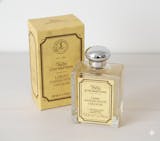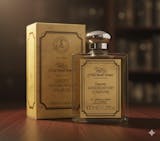Which is Better: Straight Razor Vs. Modern Safety and Cartridge?

Cartridge razors are the blueprint of modern razors, made for convenience and for men who are always on the go. But is it the best even over its traditional counterpart? We’ll let you know which is better between straight razors vs. modern razors.
To put things in proper perspective, we’re going to list the differences between the straight razor and these so-called revolutionary designed cartridge razors.
Things you need to know:
- What is a Straight Razor?
- What are Modern Razors?
- Safety Razor Vs. Cartridge
- Straight Razors Vs. Modern Razors
- Convenience of a Cartridge Razor
- Straight Razor Vs. Cartridge
What is a Straight Razor?
 A straight razor is a single-edge blade notorious for its cut-throat sharpness and ability to give the closest shave.
A straight razor is a single-edge blade notorious for its cut-throat sharpness and ability to give the closest shave.
A straight razor is a traditional type of razor featuring a pivoted design wherein its narrow single-edge blade folds back into the handle when not in use. The blades result from forging, hardening, grinding, and sharpening of primarily Japanese steel, stainless steel, carbon steel (DOVO razors for example), or sometimes Damascus steel blanks.
The blades come in different points and grinds,1 defining their shaving efficiency. Straight razors with a rounded point and hollow ground are easier for beginners as they do not have a spear-like tip and the concave on the bevel allows the shaver to angle the blade for a close shave.
Although the original design called for a fixed blade on a spine, some conventional straight razors have the same pivoted mechanism but with replaceable blades. This kind of straight razors are called shavette straight razors.
The History
You can trace the history of straight razors back to ancient Egyptian civilization,2 where they originally wore a fixed handle. It was only in the 1600s to 1800s when the design took on another form when the first folding razor became popular in Sheffield, England, with the Butcher Bros as some of its pioneers.3
Only barbers were allowed to use these straight razors in olden times because the blades made them notorious as cut-throat razors. Professional barbers used straight razors in their dual role as surgeons and as barbers, where they had to undergo training as a barber’s apprentice to use the razor.4
However, fortunately, today’s straight razor has become more streamlined and modern in design and temperament. And although anyone can now use a straight razor, barbers still include a straight razor in their toolset, and barbershops still carry on the tradition of wet shaving using a straight razor. That’s because nothing beats its versatility.
What are Modern Razors?
Unfortunately, since straight razor shaving required professional skill at that time, it was not a preferable choice for a convenient and on-the-go tool.
The Safety Razor
 A safety razor have a single-edge or double-edge disposable blade that gives a close shave with an easier learning curve than a straight razor.
A safety razor have a single-edge or double-edge disposable blade that gives a close shave with an easier learning curve than a straight razor.
The need and demand inspired inventors like Jean-Jacques Perret, William Henson, and Kampfe Brothers to design and introduce the safety or t-shaped razor, which propelled the idea behind the modern era cartridge razor.5
A safety razor is a re-envisioned version of a straight razor with a hoe-shaped design. The handle is placed perpendicularly to the head, which houses a replaceable single-edged blade similar to a straight razor’s blade but smaller. There are also more modern renditions, the double edge safety razor, which caters to double-edge blades.
The original design of safety razors called for single-edge blades,6 which are stiffer, heavier, and last longer than the double-edge ones. The two cutting edges of a DE makes up for its thinner features.
The safety razor owes its distinct and defining quality to the safety bar and combs, which lessens the exposure of a blade’s cutting edge. Therefore, accounting for a safer shaving experience.
The Cartridge Razor
 Cartridge razors have replaceable heads and are easy to use.
Cartridge razors have replaceable heads and are easy to use.
In 1895, American businessman, King Camp Gillette, had an idea to use the safety razor’s design but with a removable head or cartridge. Then, in the 1970s, he materialized the idea and developed the cartridge razor that was marketed as an improvement to the safety razor.
Gillette's pioneering cartridge razor Trac II was the first of its kind and a complete turnaround from how razors before the 20th century were built.7
The first cartridge razor is ergonomic in shape in both handle and head and usually has more than one blade tucked into a pivoted cartridge. This design keeps the blades at a predetermined angle through the shaving motion, making it convenient and easy to shave. When the blades get dull, the cartridge head is removable, ready for a new and fresh one to replace.
These days, razor companies try to outdo each other by raising the number of razor blades in a cartridge head. According to them, the more blades, the closer the shave.
The cartridge razor is a popular shaving tool that spearheaded the era of disposable blades and razors. Today’s disposable razors contain multiple blades with a plastic handle and often lubricating strips. Their blades only last at least six shaves before being disposed of.
Safety Razor Vs. Cartridge
 A safety razor has more benefits to offer than a cartridge razor.
A safety razor has more benefits to offer than a cartridge razor.
Before delving into the straight razor vs. modern razor debate, we should also first discuss how different safety razors and cartridge razors are from each other.
Many wet shaving enthusiasts have polarizing opinions on safety razors against cartridges. DE blade aficionados are keen on debunking cartridge razors' advertising and marketing shenanigans, arguing that multiple blades do not necessarily mean a closer and better shave.
We took a deep dive into several razors and shaving forums,8 and here’s some info that makes sense about shaving with safety razors vs. cartridges:
-
Lift and cut
This is the ever-famous claim about the multiple blade mechanism of lifting and cutting. According to commercials, layered razors with numerous blades work this way: blade No. 1 lifts, and the succeeding blades cut.
What do our shaving brothers have to say?
“A blade cuts, period.”
Some wet shavers argue that the first blade in a cartridge cuts like any blade, and so does the second, third, and so on. These blades just cut over the same spot again with the same level of closeness and effort.
The verdict? It shaves multiple passes in a single pass, wherein it is similar to taking two or three blades and gliding them on your skin at once, leading to more skin irritations. It is, therefore, not advisable that men with sensitive skin shave with layered razors.
-
Pressure and Close Shave
Here comes a technical issue between cartridge vs. safety razors—the pressure imposed while shaving.
Those who use cartridge razors have to put more pressure or push down the head onto the skin to get a close shave. But because the cartridge offers extra protection, putting more pressure while shaving does not result in bloody nicks. It gets the job done better instead.
Meanwhile, if you try that with a safety razor, the chances of you leaving a bloody mess on your face are higher. Safety razor blades shave close without the need to press the blade hard on the skin.
Overall, if you start with a cartridge or a disposable razor rather than using safety or DE razor, you will tend to nick yourself because you are used to pushing down the head. On the other hand, if you are experienced with a DE razor, you can ultimately get a close shave even with a cartridge.
-
Costs
Whether you believe it or not, cartridge razors are more costly than safety razors. This survey notes that the lifetime cost of shaving using disposable razors amounts up to $8,537.76!9
A pack of four disposable razors costs $20 or more if you take a closer comparison. Meanwhile, you can get an excellent DE safety razor for the same price and an affordable but high-quality pack of 100 blades.10
In the end, you save more in the long run.
The only pros of shaving with a cartridge razor is that it has an excellent error tolerance, and it is everywhere. Beginners do not need any learning curve, and they can easily buy replacements wherever they may be. But, if you have sensitive skin, lubricating strips on these modern razors will not significantly lessen the harm they will impose.
Straight Razor Vs. Modern Razors
The takeaway on cartridge vs. safety razors is that single blades are better than multiple blades because they shave closer.
But, how much is the difference between traditional straight razors vs. modern razors in general?
| Straight Razor |
Cartridge Razor
|
| Performance-wise: Gives the closest shave, with less razor burn and nicks Downside: Requires skill |
Performance-wise: Gives a close shave, and doesn’t require skill.
Downside: Will irritate sensitive skin |
| Single blade allows you versatility for shaving and trimming |
Multi-blades clog up quickly, and won’t be useful for trimming awesome beard styles
|
| Maintenance is a drag; need to strop and hone it regularly |
No need for maintenance: swipe in for a new cartridge when blades get dull
|
| Environment friendly; metal and wood are recyclable and durable |
Not usually environment friendly: cartridges are plastic which contribute to plastic pollution
|
| High-priced, one shot investment but worth it because of its durability |
Relatively inexpensive; but constant cartridge replacement may lead to longer long term costs.
|
| Needs more time |
Quick and easy
|
For straight razor users, however, a single blade is all one needs to get a closer shave. In fact, they find the multi-blade design ridiculous and a transparent attempt for razor companies to dupe consumers into buying them.11
Here are the benefits of shaving with a straight razor:
-
Closer Shave
When used by a skilled user, a straight razor blade can efficiently cut hair closer to the skin for a smooth shave than any multi-blade cartridge razor. And because there is only a single blade shaving the skin, it reduces the incidences of razor burn, a common type of skin irritation among those with sensitive skin.
-
Cleaner Shave
Straight shaving is cleaner than shaving with cartridges or electric razors or electric shavers, reducing the risk of common skin infections like ingrown hairs, razor burn, and razor bumps. Safety bars, lubricating strips, multiple blades, and motors are difficult to clean and clog with hair, skin, shaving soap, lather residue, and dirt. Cleaning a straight razor blade can easily be done after each pass as you have full access to all of its blade surface.
The more blades in a cartridge, the easier the blades get clogged. It is unhygienic, but it also increases the chances of razor bumps because the succession of blades can cut the hair under the skin.12 Instead of growing outward, the newly cut hair grows inward, resulting in bumps and a nasty case of skin irritation.
-
Better for Coarse, Thick, and Curly Hair
For those with coarse and curly hair, using a straight razor will also reduce ingrown hairs or razor bumps. That’s because its single blade cleanly cuts the hair, with no second or third (or even fifth!) blade following up to cut the hair under the skin.
-
Versatility
A straight razor is also versatile, as proven in its use over the centuries. Whether for shaving the hair off one’s head as Egyptians13 used to do or trimming facial hair into fashionable styles, like the English gentry,14 a straight razor is the ultimate facial hair grooming accessory.
Cartridge razors are not as versatile as straight razors. It’s hard to trim a beard style using a cartridge razor; the design alone won’t allow you to reach those parts on your face that need delicate and precise trimming.
-
Ecological
It’s environment friendly. Straight razors are made of durable steel blades and wooden handles. They’re not produced with a carbon footprint, and they’re recyclable.
Straight razors are also cost-efficient, despite their relatively expensive prices these days. You’re better off plunking down hard-earned money for one single investment rather than spending years buying replacement blades.
On the other hand, cartridge razors are not environmentally friendly. These razors have plastic, metal, lubricating strips, and rubber, not generally recycled. At last count, some two billion plastic razor blades are thrown into the landfill every year. Guess how that's making an impact on our environment.
Straight razors are produced to last, often becoming heirlooms passed down from father to son. If it’s a high-quality straight razor, it will be more valuable over time.
The downside to a straight razor? It requires time and skill. Maintaining a straight razor requires stropping the blade on a leather strop and honing it occasionally. One needs to spend time learning how to do it properly and regularly so that it remains its sharp blade.
For straight razor purists, though, time is something they’re willing to spend just so they’re able to get the closest shave that a straight razor can give. In fact, it’s the one thing that elevates the shaving routine into an art form and a masculine ritual. Having some “Me Time” shaving with a straight razor every morning does wonders for one’s outlook for the day.
Convenience of a Cartridge Razor
But for those who want to cut to the chase, a cartridge razor is their go-to and best razors for wet shaving.
In fact, that’s how razor companies are marketing them. Cartridge razors give a quick and easy close shave comparable to a straight-edge razor. Gillette calls this the “hysteresis process”15 where the multi-blade cartridge creates a comfortable and smooth shaving experience for the user.
It’s a quick way to achieve a close shave, made easier because it is designed without the user needing some skill to shave. It doesn’t even require maintenance; once the blades become dull, just replace the cartridge head with a new one.
The best part? You can also travel easily with cartridge razors. Traveling with a straight razor in your carry-on violates TSA-regulations, but you can pack your single-edge in your checked luggage.
Straight Razor Vs. Cartridge?
 Naked Armor’s Solomon Straight Razor is made from a Japanese Steel blade and algum wood handle, giving you the perfect balance you need to achieve a close shave with less chances of getting nicked.
Naked Armor’s Solomon Straight Razor is made from a Japanese Steel blade and algum wood handle, giving you the perfect balance you need to achieve a close shave with less chances of getting nicked.
Between straight razors vs. modern razors, like cartridges and safety, straight razors give a better shave overall, despite the learning curve. The single-edge blade without any safety bars lets you see the correct angle you need for a skin-level shave without the risk of imposing too much irritation. This advantage makes it the best alternative to modern razors.
Ultimately, though, it’s all a matter of your personal preference, newbie.
Nothing beats using a cartridge razor for that first experience in shaving. However, as you adopt a regular shaving routine throughout the years, your shaving needs will also change. You will need a more versatile tool than a cartridge razor and look for the best straight razor.
Here at Naked Armor, we have a fine selection of straight razors that will make your shaving experience easy, comfortable, and luxurious.
Our razors are made with high-quality Japanese steel, with durable wooden handles sourced from sandalwood, one of the world’s most valuable timbers.
Our Spartacus Sandalwood Safety Razor Kit features a durable sandalwood handle + stainless steel accented end caps for the perfect face-to-shave ratio and balance.
Meanwhile, the Solomon Straight Razor, with its hardness rating of 61-65 HRC, is designed to be a hybrid of a full hollow and a half hollow to make sure that we capture all the best aspects of razor shaving.
If you’re looking for a kit that gives you all the shaving essentials you will need, click Add to Cart to get started on your wet shaving experience.
More Essential Reads
Safety Razor vs Straight Razor
Is A Straight Razor The Best Shave?
Best Straight Razor For Sensitive Skin Vs. Disposable And Safety
References:
- Different Types of Straight Razors: Grinds, Points, Notches & Designs. Bespoke Unit. https://bespokeunit.com/shaving/straight-razor/designs/
- J. Attebery, P. Kiger. 10 Amazing Ancient Egyptian Inventions. HowStuffWorks. https://science.howstuffworks.com/innovation/inventions/5-amazing-ancient-egyptian-inventions.htm#pt8. December 16, 2021
- Z. Jarvis. A Durable Mystery. The Shivering Beggar. https://theshiveringbeggar.com/2012/08/an-enduring-mystery/
- E. Hemingway. A Free Shave. The Hemingway Papers. https://ehto.thestar.com/marks/a-free-shave
- A. Ali. The History & Evolution Of Shaving. Visual Capitalist. https://www.visualcapitalist.com/the-history-evolution-of-shaving/. April 18, 2022
- Hats the difference between single edge and DE and why is one more prevalent? r/wicked_edge. https://www.reddit.com/r/wicked_edge/comments/2bmdbh/hats_the_difference_between_single_edge_and_de/
- History Of Shaving. Badger & Blade. https://www.badgerandblade.com/forum/wiki/History_of_Shaving#Cartridge_Razors
- Cartridges or safety razors? Badger & Blade. https://www.badgerandblade.com/forum/threads/cartridges-or-safety-razors.167419/
- J. Anderer. Average American spends over $11K on toilet paper over a lifetime — enough to buy a Rolex! Study Finds. https://www.studyfinds.org/average-american-toilet-paper/. August 26, 2020
- Safety Razors vs Cartridge Razors. r/wicked_edge. https://www.reddit.com/r/wicked_edge/comments/ag6njx/safety_razors_vs_cartridge_razors/
- The Evolution of Shaving and Why It’s A Rip Off. Of Iron and Oak. https://ofironandoak.com/2013/06/the-evolution-of-shaving-and-why-its-a-rip-off/
- L. Cantor. 3-Blade Razor vs 5-Blade Razor – Which is Best? https://www.leesrazors.com/3-blade-razors-vs-5-blade-razors/#:~:text=If%20you're%20trying%20to,can%20be%20the%20better%20option. February 12, 2022
- B. McKay, K. McKay. Unique Shaving & Grooming Rituals from History and Around the World. https://www.artofmanliness.com/articles/shaving-rituals/. June 7, 2012
- Plucked,Shaved,Braided – Grooming in the Middle Ages. https://www.interesly.com/pluckedshavedbraided-grooming-in-the-middle-ages/. September 22, 2016
- Why Gillette Razors Have So Many Blades. Gillette. https://gillette.com/en-us/shaving-tips/shaving-science/why-do-more-razor-blades-matter
- Different Types of Straight Razors: Grinds, Points, Notches & Designs. Bespoke Unit. https://bespokeunit.com/shaving/straight-razor/designs/
- J. Attebery, P. Kiger. 10 Amazing Ancient Egyptian Inventions. HowStuffWorks. https://science.howstuffworks.com/innovation/inventions/5-amazing-ancient-egyptian-inventions.htm#pt8. December 16, 2021
- Z. Jarvis. A Durable Mystery. The Shivering Beggar. https://theshiveringbeggar.com/2012/08/an-enduring-mystery/
- E. Hemingway. A Free Shave. The Hemingway Papers. https://ehto.thestar.com/marks/a-free-shave
- A. Ali. The History & Evolution Of Shaving. Visual Capitalist. https://www.visualcapitalist.com/the-history-evolution-of-shaving/. April 18, 2022
- Hats the difference between single edge and DE and why is one more prevalent? r/wicked_edge. https://www.reddit.com/r/wicked_edge/comments/2bmdbh/hats_the_difference_between_single_edge_and_de/
- History Of Shaving. Badger & Blade. https://www.badgerandblade.com/forum/wiki/History_of_Shaving#Cartridge_Razors
- Cartridges or safety razors? Badger & Blade. https://www.badgerandblade.com/forum/threads/cartridges-or-safety-razors.167419/
- J. Anderer. Average American spends over $11K on toilet paper over a lifetime — enough to buy a Rolex! Study Finds. https://www.studyfinds.org/average-american-toilet-paper/. August 26, 2020
- Safety Razors vs Cartridge Razors. r/wicked_edge. https://www.reddit.com/r/wicked_edge/comments/ag6njx/safety_razors_vs_cartridge_razors/
- The Evolution of Shaving and Why It’s A Rip Off. Of Iron and Oak. https://ofironandoak.com/2013/06/the-evolution-of-shaving-and-why-its-a-rip-off/
- L. Cantor. 3-Blade Razor vs 5-Blade Razor – Which is Best? https://www.leesrazors.com/3-blade-razors-vs-5-blade-razors/#:~:text=If%20you're%20trying%20to,can%20be%20the%20better%20option. February 12, 2022
- B. McKay, K. McKay. Unique Shaving & Grooming Rituals from History and Around the World. https://www.artofmanliness.com/articles/shaving-rituals/. June 7, 2012
- Plucked,Shaved,Braided – Grooming in the Middle Ages. https://www.interesly.com/pluckedshavedbraided-grooming-in-the-middle-ages/. September 22, 2016
- Why Gillette Razors Have So Many Blades. Gillette. https://gillette.com/en-us/shaving-tips/shaving-science/why-do-more-razor-blades-matter





























When I was working in a salon, a client friend wanted me to use a straight razor on his neck but asked me to first practice on a balloon using shaving cream. This took my fear away and I was ready to shave him! I also wielded a straight razor for hair cutting and it was so satisfying having difficult hair “behave” and create more texture and movement for everyone, even fine, thin hair..
Hey Bob! Thank you for sharing your preference with us. A safety razor is a razor we love too. :)
I prefer the safety type because they shave closer, are easier to clean, and a pack of 10 blades costs about 1/3 of the price of the same number of cartridges. I’ve seen my Grandfather use a straight razor many times, but don’t trust myself with one.
We 100% agree with you, Paul!
All you have to do is shave once with a straight razor and you will see why it is a superior shave. yes they are expensive but if you take care of it you will be able to pass it down for generations.
Leave a comment